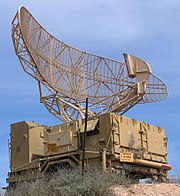
Back Radar Afrikaans Radar ALS Radar AN رادار Arabic ৰাডাৰ Assamese Radar AST Radar Azerbaijani Радар Byelorussian Радыёлякацыйная станцыя BE-X-OLD Радиолокатор Bulgarian
Radar is a system that uses radio waves to determine the distance (ranging), direction (azimuth and elevation angles), and radial velocity of objects relative to the site. It is a radiodetermination method[1] used to detect and track aircraft, ships, spacecraft, guided missiles, motor vehicles, map weather formations, and terrain.
A radar system consists of a transmitter producing electromagnetic waves in the radio or microwaves domain, a transmitting antenna, a receiving antenna (often the same antenna is used for transmitting and receiving) and a receiver and processor to determine properties of the objects. Radio waves (pulsed or continuous) from the transmitter reflect off the objects and return to the receiver, giving information about the objects' locations and speeds.
Radar was developed secretly for military use by several countries in the period before and during World War II. A key development was the cavity magnetron in the United Kingdom, which allowed the creation of relatively small systems with sub-meter resolution. The term RADAR was coined in 1940 by the United States Navy as an acronym for "radio detection and ranging".[2][3][4][5][6] The term radar has since entered English and other languages as a common noun, losing all capitalization.
The modern uses of radar are highly diverse, including air and terrestrial traffic control, radar astronomy, air-defense systems, anti-missile systems, marine radars to locate landmarks and other ships, aircraft anti-collision systems, ocean surveillance systems, outer space surveillance and rendezvous systems, meteorological precipitation monitoring, radar remote sensing, altimetry and flight control systems, guided missile target locating systems, self-driving cars, and ground-penetrating radar for geological observations. Modern high tech radar systems use digital signal processing and machine learning and are capable of extracting useful information from very high noise levels.
Other systems which are similar to radar make use of other parts of the electromagnetic spectrum. One example is lidar, which uses predominantly infrared light from lasers rather than radio waves. With the emergence of driverless vehicles, radar is expected to assist the automated platform to monitor its environment, thus preventing unwanted incidents.[7]
- ^ ITU (2020). "Chapter I – Terminology and technical characteristics" (PDF). Radio Regulations. International Telecommunications Union (ITU). Retrieved 24 March 2024.
- ^ Translation Bureau (2013). "Radar definition". Public Works and Government Services Canada. Archived from the original on 4 January 2014. Retrieved 8 November 2013.
- ^ McGraw-Hill dictionary of scientific and technical terms / Daniel N. Lapedes, editor in chief. Lapedes, Daniel N. New York; Montreal : McGraw-Hill, 1976. [xv], 1634, A26 p.
- ^ "Radio Detection and Ranging". Nature. 152 (3857): 391–392. 2 October 1943. Bibcode:1943Natur.152..391.. doi:10.1038/152391b0.
- ^ "Remote Sensing Core Curriculum: Radio Detection and Ranging (RADAR)". University of Minnesota. Archived from the original on 2 June 2021. Retrieved 31 May 2021.
- ^ Duda, Jeffrey D. "History of Radar Meteorology" (PDF). Archived from the original on 2 March 2023. Retrieved 2 March 2023.
Note: the word radar is actually an acronym that stands for RAdio Detection and Ranging. It was officially coined by U.S. Navy Lieutenant Commanders Samuel M. Tucker and F.R. Furth in November 1940
{{cite web}}: CS1 maint: bot: original URL status unknown (link) - ^ Fakhrul Razi Ahmad, Zakuan; et al. (2018). "Performance Assessment of an Integrated Radar Architecture for Multi-Types Frontal Object Detection for Autonomous Vehicle". 2018 IEEE International Conference on Automatic Control and Intelligent Systems (I2CACIS). Retrieved 9 January 2019.

